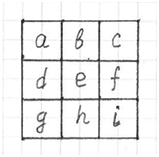
Noise Reduction using Combined Linear-Median Filter is used in video processing to remove artifacts created by using linear and median spatial filters separately.
Spatial 2-D linear filtering may efficiently reduce noise by using the weighted average of the current pixel with adjacent neighbouring pixels. It’s very efficient in smooth or flat areas, but may cause blurring, especially in the presence of high level transitions such as strong edges or strong texture details.
2-D median filtering is very efficient in the case of standalone outliers (such as salt and paper noise). However, in smooth areas it may create undesirable spots if adjacent pixels have the same levels. This makes the image look more artificial.
These issues may be resolved by using a combination of median and linear filters.
The spatial aperture of the filter contains N adjacent pixels (N– odd number). Fig. 1 shows an example of a 9 pixel aperture.
The algorithm for the combination median-linear filter is as follows:
First, all N pixels covered by the filter aperture have to be arranged in ascending order. Assuming the arranged pixels have indexes from 0 to N-1, a subset of K pixels (1<K<N, K-odd number) with indexes from ![]() is extracted. For this subset, the linear filtering is applied. In the simplest case, it can be an averaging filter.
is extracted. For this subset, the linear filtering is applied. In the simplest case, it can be an averaging filter.